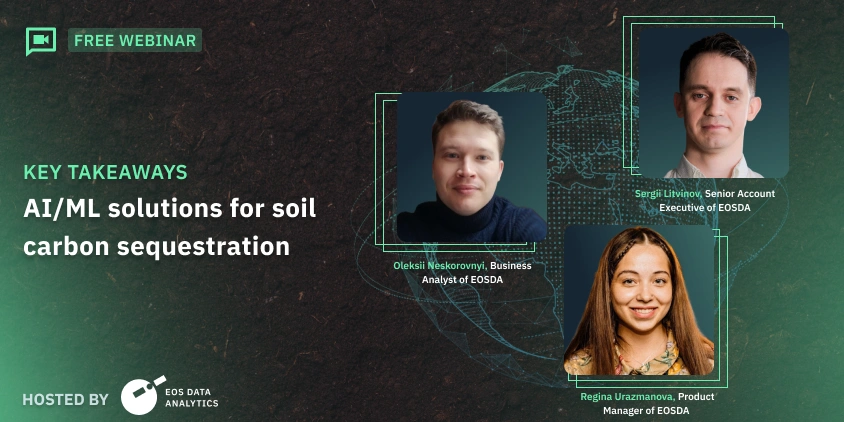
AI/ML Solutions For Soil Carbon Sequestration
During the free webinar on March 26th, 2024, EOS Data Analytics (EOSDA) experts discussed the current trends of soil organic carbon (SOC) sequestration, its use in precision agriculture, and the agrarians’ broader pursuit of sustainability. The webinar focused on AI and ML solutions for carbon sequestration, subsequent impact on climate change, and other available precision farming tools.
To access the presentation, follow the link.
The webinar was a must-attend for current and potential EOS Data Analytics clients and partners, agriculture-, carbon-, and GIS-oriented businesses and organizations, journalists, climate volunteers and activists, GIS scientists and students, green enthusiasts, and environmentalists interested in precision agriculture and carbon capture.
Attendees were among the first to hear about this new EOSDA custom solution, soil organic carbon modeling, and were introduced to the innovative approach towards carbon sequestration. The webinar had powerful presentations by the following speakers:
- Sergii Litvinov, Senior Account Executive at EOS Data Analytics
- Regina Urazmanova, Product Manager at EOS Data Analytics
- Oleksii Neskorovnyi, Business Analyst at EOS Data Analytics
The topics discussed during the webinar were:
- The story of EOSDA and agricultural products’ portfolio.
- The model description for SOC assessment, including the methodology and required data description.
- EOSDA’s predictions of SOC using models like RothC.
- Budget savings of up to 90% on soil sampling.
- Abilities of cover crops, crop rotation, and tillage monitoring to stimulate CO2 sequestration from the atmosphere and mitigate climate change.
- Custom solutions like Field Boundary Detection and Crop Classification and their enhancements to allow farmers to get more carbon credits when added to certain practices.
- Real-world use cases in Canada, Greece, and Australia of custom solutions’ application in soil carbon sequestration assessment.
The discussion covered field activities farmers should do to expand the amount of soil organic carbon, and how they can get carbon credits. The speakers also touched upon why farmers should take the SOC baseline and how EOSDA technologies help detect the amount of SOC more precisely.
Experts explained the SOC model in detail. For instance, how the data such as weather, soil, relief, and land cover data, along with the vegetation indices, allow the model to work correctly. EOSDA can use up to 140 SOC predictors for model development. The speakers discussed how custom solutions like field boundary detection and crop classification could be useful to the farmers in capturing CO2 on their land and covered their methodologies. Real-world use cases were also shared, describing how these EOSDA custom solutions helped clients from Canada, Greece, and Australia achieve their sustainability and carbon sequestration goals.
The webinar ended with a Q&A session, allowing attendees to ask the presenters questions about the discussed topics.